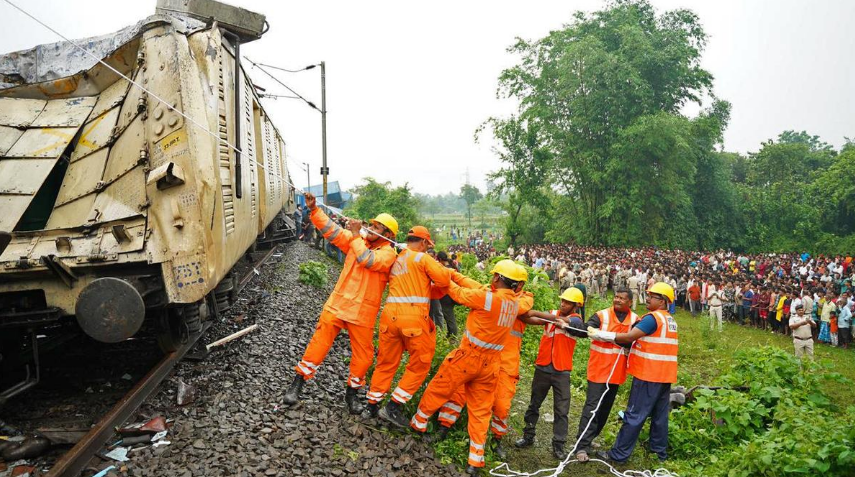In a devastating turn of events, the serene landscapes of West Bengal’s Darjeeling district bore witness to tragedy on June 17, 2024, as the Sealdah-bound Kanchenjunga Express collided with a goods train in the Rangapani-Chattarhat section of Northeast Frontier Railway’s (NFR) Katihar Division. The collision, which claimed the lives of nine individuals, has sent shockwaves through the railway community and raised pertinent questions about safety protocols and emergency response measures.
Immediate Aftermath and Operational Disruptions
The collision occurred during routine transit, shattering the tranquility of the day and leaving a trail of destruction in its wake. Promptly responding to the crisis, NFR authorities swiftly mobilized rescue and recovery efforts, focusing initially on securing the accident site and ensuring the safety of survivors and railway personnel.
The impact of the collision necessitated the immediate suspension of train services along the affected stretch. The Up line towards Guwahati was restored by 5:40 PM on the day of the incident, followed by the reopening of the Down line towards Sealdah/Delhi at 7:30 AM the next morning. However, the restoration efforts came with significant operational challenges, compelling the diversion of 22 passenger trains, including high-profile services like the New Delhi-Dibrugarh Rajdhani Express and the Silchar-Sealdah Kanchenjunga Express. These diversions, adding approximately 26 kilometers to their usual routes via Rangapani and Chattarhat, were necessary to manage the flow of traffic and mitigate further disruptions.
Challenges and Response
In the wake of the tragedy, railway authorities faced multiple challenges, ranging from logistical hurdles in rerouting trains to the urgent need for track repairs and safety inspections. The ballasts under the damaged tracks required a full 24 hours to stabilize, during which trains passing through the area were required to operate at reduced speeds as a precautionary measure.
The incident also prompted the cancellation of six trains, including two Shatabdis and four intercity services, while the New Jalpaiguri-New Delhi Superfast Express was rescheduled to accommodate the backlog of delayed and stranded passengers. Despite these measures, the disruption caused by the accident reverberated across the region’s railway network, underscoring the vulnerabilities inherent in maintaining a safe and efficient transport system.
Passenger Welfare and Community Support
Amid the chaos and upheaval, efforts were made to prioritize the welfare of affected passengers. Medical teams were deployed at stations along the route, including Malda town and Sealdah, to provide immediate medical assistance to those in need. Adequate provisions of food and water were also ensured, offering some solace to passengers grappling with the aftermath of the harrowing experience.
The State’s transport department played a crucial role in providing logistical support, arranging buses and other vehicles at Sealdah station to facilitate the onward journeys of passengers disembarking there. Such coordinated efforts were instrumental in restoring a semblance of normalcy and offering support to those directly impacted by the tragedy.
Political and Public Response
In the aftermath of the incident, voices of concern and criticism emerged from various quarters. Kolkata Mayor Firhad Hakim condemned the central government’s response, alleging negligence and advocating for stricter oversight of railway safety measures. Such sentiments echoed broader public concerns about the adequacy of infrastructure investments and safety protocols within India’s vast and intricate railway network.
Looking Ahead
As the affected communities and railway authorities grapple with the aftermath of this tragic incident, the focus remains on learning from the past to prevent future mishaps. The Kanchenjunga Express collision serves as a stark reminder of the inherent risks associated with mass transportation and the imperative of robust safety mechanisms.
Moving forward, there is a collective call for enhanced vigilance, comprehensive safety audits, and swift emergency response protocols to safeguard passengers and railway personnel alike. The incident has sparked a renewed dialogue on the need for sustained investments in infrastructure and technology to bolster the resilience of India’s railway network against unforeseen challenges and tragedies.
Conclusion
In conclusion, the Kanchenjunga Express train accident stands as a poignant chapter in the annals of India’s railway history—a reminder of the fragility of life and the resilience of communities in times of adversity. As the nation mourns the lives lost and supports those affected, there is a shared resolve to transform tragedy into an opportunity for systemic improvement and renewed commitment to ensuring the safety and security of every passenger who entrusts their journey to the railways.




